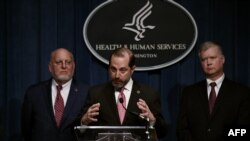Even as the novel coronavirus continues to spread to more countries around the world, U.S. officials say the risk of infection to Americans remains low.
“Our assessment of the immediate risk to the American public from the virus remains the same as last week. … The immediate risk to the American public is low at this time,” Health and Human Services Secretary Alex Azar said at a joint briefing on Friday by President Donald Trump’s Coronavirus Task Force.
Azar is leading the federal coronavirus response that is composed of top officials from the White House, U.S. Centers for Disease Control and Prevention, National Institutes of Health, State Department and Department of Homeland and Security.
Currently, 12 cases of the virus are reported in the United States in Wisconsin, California, Arizona, Massachusetts, Washington and Illinois.
Last week, the Trump administration declared the novel coronavirus a public health emergency. It announced a presidential proclamation, suspending entry for non-U.S. citizens who had recently visited China and quarantining Americans who visited China’s Hubei province in the last 14 days.
While health experts doubt the effectiveness of the travel restrictions in keeping the virus at bay, officials explained the measures would slow the spread of the disease. “
I think many public health officials would agree that although it’s not perfect, it could delay (the spread). And what we needed was the delay to essentially prepare better, also to get a better feel of where this is going,” Dr. Anthony Fauci, director of the National Institute of Allergy and Infectious Disease, said.
Officials at the briefing also explained the rigorous screening efforts underway at the ports of entry.
All flights to the U.S. from China are funneled to 11 major airports.
Joel Szabat, acting under secretary for policy at the Transportation Department, said, “This involves over 1,000 daily flights inbound to the U.S., being carried by over 400 air carriers, from 288 airports worldwide.”
At these 11 airports, passengers who recently visited China are subject to a three-layer screening, first by the Office of the Field Operations, then by medical personnel, and, lastly, by officials with the Centers for Disease Control and Prevention. “
The multilayer system that we’ve put out has got us in a mode of containment,” Dr. Robert Redfield, director of the Centers for Disease Control and Prevention, said.
The U.S. also has offered to send experts to Wuhan, the epicenter of the new coronavirus, but China has yet to respond. Azar said Washington is optimistic they will accept the medical help.
“Primarily, our activities would be to learn more about the nature of this virus with our expertise,” he said, adding that virologists, drug development experts and epidemiologists would be part of the team.
The State Department Friday also announced $100 million in aid to China and other impacted countries, to contain and combat the coronavirus. The U.S. has already delivered 18 tons of medical supplies, including masks, gowns and respirators to Wuhan.
The number of people infected worldwide rose to more than 31,400 and the death toll to nearly 640.








